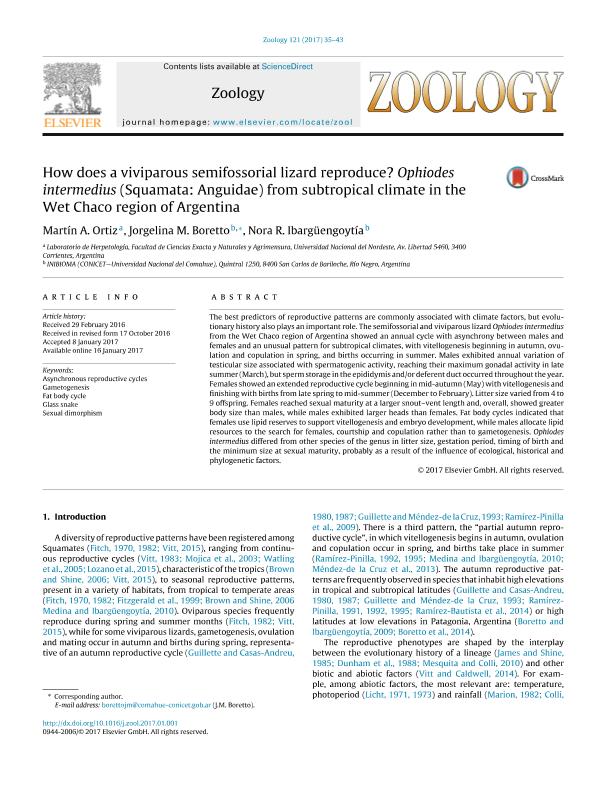Artículo
How does a viviparous semifossorial lizard reproduce? Ophiodes intermedius (Squamata: Anguidae) from subtropical climate in the Wet Chaco region of Argentina
Fecha de publicación:
04/2017
Editorial:
Elsevier Gmbh
Revista:
Zoology
ISSN:
0944-2006
Idioma:
Inglés
Tipo de recurso:
Artículo publicado
Clasificación temática:
Resumen
The best predictors of reproductive patterns are commonly associated with climate factors, but evolutionary history also plays an important role. The semifossorial and viviparous lizard Ophiodes intermedius from the Wet Chaco region of Argentina showed an annual cycle with asynchrony between males and females and an unusual pattern for subtropical climates, with vitellogenesis beginning in autumn, ovulation and copulation in spring, and births occurring in summer. Males exhibited annual variation of testicular size associated with spermatogenic activity, reaching their maximum gonadal activity in late summer (March), but sperm storage in the epididymis and/or deferent duct occurred throughout the year. Females showed an extended reproductive cycle beginning in mid-autumn (May) with vitellogenesis and finishing with births from late spring to mid-summer (December to February). Litter size varied from 4 to 9 offspring. Females reached sexual maturity at a larger snout–vent length and, overall, showed greater body size than males, while males exhibited larger heads than females. Fat body cycles indicated that females use lipid reserves to support vitellogenesis and embryo development, while males allocate lipid resources to the search for females, courtship and copulation rather than to gametogenesis. Ophiodes intermedius differed from other species of the genus in litter size, gestation period, timing of birth and the minimum size at sexual maturity, probably as a result of the influence of ecological, historical and phylogenetic factors.
Archivos asociados
Licencia
Identificadores
Colecciones
Articulos(CCT - NORDESTE)
Articulos de CTRO.CIENTIFICO TECNOL.CONICET - NORDESTE
Articulos de CTRO.CIENTIFICO TECNOL.CONICET - NORDESTE
Articulos(INIBIOMA)
Articulos de INST. DE INVEST.EN BIODIVERSIDAD Y MEDIOAMBIENTE
Articulos de INST. DE INVEST.EN BIODIVERSIDAD Y MEDIOAMBIENTE
Citación
Ortiz, Martín Alejandro; Boretto, Jorgelina Mariela; Ibarguengoytía, Nora; How does a viviparous semifossorial lizard reproduce? Ophiodes intermedius (Squamata: Anguidae) from subtropical climate in the Wet Chaco region of Argentina; Elsevier Gmbh; Zoology; 121; 4-2017; 35-43
Compartir
Altmétricas




